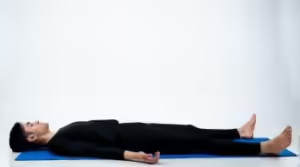Learn yoga nidra for best sleep results
Table of Contents
🧘Yoga Nidra vs. Meditation
Ever wondered whether Yoga nidra for sleep or meditation is better for sleep? Which Helps You Sleep Better?

When it comes to improving sleep, both Yoga nidra for sleep and meditation are powerful tools, but they work in different ways. Yoga Nidra, often called “yogic sleep,” is a guided practice that leads you into a state of deep relaxation, almost like hovering between sleep and wakefulness. It’s perfect if you struggle to unwind at night because it helps calm the nervous system and lets go of stress.
On the other hand, meditation focuses on quieting the mind through techniques like breathing exercises or mindfulness. While meditation can also help with sleep, it’s more about building long-term mental clarity and relaxation rather than immediate sleep readiness.
So, which is better for sleep? If you need something to help you drift off tonight, Yoga nidra for sleep might be your best bet. But if you’re looking to reduce overall stress and improve sleep quality over time, meditation could be the way to go.
New to Yoga Nidra?
Whether you’re new to the practice or just curious, this guide will walk you through the basics and what to expect in your first session.
What is Yoga nidra for sleep?
Yoga nidra for sleep also known as “yogic sleep,” is a form of guided meditation that leads you into a state of deep relaxation while remaining conscious. Unlike traditional meditation, where you might sit and focus on your breath or a mantra, Yoga Nidra involves lying down comfortably and listening to a guide who takes you through a series of relaxation steps.
🫄Yoga Nidra for a Restful Pregnancy

Struggling with sleep during pregnancy?
Pregnancy is an incredible experience, but it often comes with its own set of challenges, particularly when it comes to sleep. As your body changes and the baby grows, finding a comfortable sleeping position can become increasingly difficult. This is where Yoga nidra for sleep can be a valuable tool. It’s a safe, soothing practice that helps expectant mothers relax deeply and improve their sleep, providing much-needed relief throughout pregnancy.
Yoga Nidra in the First Trimester
In the first trimester, your body is adjusting to the new demands of pregnancy. Fatigue is common, and you might find yourself needing more rest. Practicing Yoga nidra for sleep during this time can help manage this fatigue by providing a dedicated time for deep, restorative rest.
Yoga nidra for sleep in the Second Trimester
As your pregnancy progresses into the second trimester, physical changes become more noticeable. Sleep might become harder as finding a comfortable position becomes challenging. Yoga nidra for sleep can help by guiding you into a state of deep relaxation, making it easier to fall asleep and stay asleep. Lying on your side with pillows for support can make the practice more comfortable.
Yoga nidra for sleep in the Third Trimester
In the third trimester, sleep challenges can intensify. The baby’s movements, along with increased physical discomfort, can make restful sleep feel impossible. Yoga Nidra can be especially helpful in these final months, offering a way to deeply relax and reduce anxiety about the approaching birth.
Yoga nidra for sleep is a gentle, nurturing practice that can help you get the rest you need during pregnancy.
🛏️perfect environment for Yoga nidra for sleep
It can greatly enhance your experience and improve your sleep quality.
Choose a Quiet, Calm Space
Start by selecting a room or area in your home where you won’t be disturbed. It could be your bedroom, living room, or any quiet corner.
Adjust the Lighting
Dim the lights or use soft, warm lamps to create a calming ambiance. If you practice during the day, consider using blackout curtains to block out excess light. A sleep mask can also be helpful if you prefer complete darkness.
Set the Right Temperature
Make sure the room is comfortably warm but not too hot. You want to feel cozy, so adjust the thermostat or use a blanket to maintain the right temperature.
Use Comfortable Props

Comfort is essential in Yoga nidra for sleep. Lie down on a soft yoga mat or a firm mattress. Place a pillow under your head and another under your knees to support your lower back. You can also use a bolster or rolled-up blanket under your knees for added comfort.
Minimize Noise
Reduce noise as much as possible. If you live in a noisy area, consider using a white noise machine or calming nature sounds to drown out background noise.
Add Personal Touches
To make the space feel more inviting, add elements like your favorite essential oils in a diffuser, a soft blanket, or a comforting eye pillow.
📋Yoga Nidra Scripts for Sleep
Guided Practices You Can Try Tonight
Body Scan for Deep Relaxation
Purpose: To release tension from your entire body, helping you relax deeply and prepare for sleep.
Script:
Start by Relaxing with Your Breath: Lie down comfortably, close your eyes, and take a few deep breaths.
Focus on Your Feet: Bring your attention to your feet. As you breathe out, imagine the tension in your feet melting away.
Move Up Your Body: Gradually shift your focus to your legs, hips, abdomen, chest, arms, shoulders, and finally your head and face. At each step, imagine the tension leaving that area as you exhale.
Whole Body Relaxation: Once you’ve relaxed each part, take a moment to feel your entire body at ease. Enjoy this sensation of total relaxation.
Explanation: The body scan technique helps you become aware of and release any tension in your body, part by part. This focused relaxation calms your nervous system, making it easier to fall asleep.
Breathing for Calm and Clarity
Purpose: To calm the mind and body by focusing on slow, deep breathing, which promotes relaxation and prepares you for sleep.
Script:
Focus on Your Breath: Lie down comfortably and close your eyes. Begin by noticing your breath, without trying to change it.
Deep Breathing: Slowly inhale through your nose for a count of four, hold for a count of two, then exhale through your mouth for a count of six. Repeat this several times.
Count Your Breaths: If your mind starts to wander, gently bring it back by counting your breaths. Continue breathing deeply, letting your body relax more with each exhale.
Explanation: Deep breathing activates your parasympathetic nervous system, which helps your body relax. Focusing on your breath also distracts your mind from stressful thoughts, making it easier to drift into sleep.
Visualization for Peaceful Sleep
Purpose: To guide your mind into a peaceful state by imagining a calming scene, helping you let go of stress and prepare for sleep.
Script:
Create Your Scene: Close your eyes and imagine a peaceful place, like a quiet beach, a tranquil forest, or a cozy room. Picture every detail—how it looks, sounds, and feels.
Immerse Yourself: Imagine yourself in this place, experiencing the peace and calm. Feel the warmth of the sun, hear the gentle waves, or smell the fresh forest air.
Stay with the Image: Stay focused on this peaceful scene, allowing your body to relax more deeply. Let this calm feeling wash over you as you drift off to sleep.
Explanation: Visualization helps shift your mind away from daily worries by engaging it in a peaceful, imaginary scene. This mental distraction, combined with the calming imagery, makes it easier to relax and fall asleep.
Affirmations for Positive Sleep
Purpose: To cultivate a positive mindset before bed, easing your mind and setting the stage for restful sleep.
Script:
Choose Your Affirmations: Lie down comfortably and choose a few positive affirmations, such as “I am calm,” “I am relaxed,” or “I am ready for sleep.”
Repeat in Your Mind: Close your eyes and slowly repeat these affirmations in your mind. You can also speak them softly if you prefer.
Focus on the Meaning: As you repeat the affirmations, focus on the meaning of each one. Imagine yourself becoming more relaxed with each repetition.
Explanation: Affirmations help replace negative thoughts with positive ones. By focusing on calming, reassuring phrases, you create a peaceful mental state that’s conducive to sleep.
Yoga Nidra for Letting Go
Purpose: To release the mental and emotional stress of the day, helping you enter a state of deep relaxation before sleep.
Script:
Review Your Day: Lie down comfortably, close your eyes, and mentally review your day. Acknowledge any thoughts or emotions that come up.
Release Each Thought: As you breathe out, imagine releasing each thought or emotion. Picture them floating away like clouds in the sky.
Focus on the Present Moment: Once you’ve released your thoughts, focus on the present moment. Feel the support of the surface beneath you, your breath, and the sensation of relaxation spreading through your body.
Explanation: This script helps you let go of any lingering thoughts or emotions from the day, allowing you to enter a peaceful, restful state. By mentally releasing your worries, you create space for relaxation and sleep.
You can find audio versions of these scripts online, or you can record them yourself if you prefer a personal touch.
🤓Science Behind Yoga nidra for sleep
Curious about how Yoga nidra for sleep
Yoga nidra for sleep promotes deep, restful sleep by influencing how your brain and nervous system function. Here’s a simple explanation of the science behind it.
Brain Waves:
During Yoga nidra for sleep, your brain waves shift to slower frequencies. Normally, when you’re awake and alert, your brain produces beta waves. As you relax, your brain transitions to alpha waves, which are associated with calm and relaxation. In deep Yoga Nidra, your brain produces theta waves, which are linked to deep meditation and sleep. This shift in brain waves helps calm your mind and prepares your body for sleep.
Stress Reduction:
Yoga nidra for sleep lowers the levels of stress hormones like cortisol in your body. When you’re stressed, your body produces more cortisol, which can interfere with sleep. By promoting relaxation, Yoga Nidra helps reduce cortisol levels, making it easier for you to fall asleep and stay asleep.
Muscle Relaxation:
Yoga nidra for sleep also helps relax your muscles. When your body is in a state of deep relaxation, the muscles are less tense, which reduces physical discomfort and makes it easier to drift off to sleep.
Mindfulness:
The practice encourages mindfulness, or being present in the moment. By focusing on calming techniques and letting go of worries, Yoga Nidra helps clear your mind, which can make it easier to fall asleep.
🛌Make Yoga nidra Part of Your Nightly Routine
Learn how to effortlessly incorporate Yoga nidra for sleep into your evening routine.
Choose the Right Time
Pick a time in the evening when you can consistently practice Yoga nidra for sleep. Ideally, aim for about 30 minutes to an hour before you plan to go to bed.
Set Up a Relaxing Space
Create a calming environment where you can practice Yoga nidra for sleep. Find a quiet spot in your home, such as a cozy corner in your bedroom or living room. Use soft lighting, like a dim lamp or candles, and make sure the room is comfortably warm. Use a yoga mat or a soft blanket to lie on, and place pillows under your head and knees for added comfort.
Integrate into Your Routine
To make Yoga Nidra a habit, integrate it into your nightly routine. For example, you can start by brushing your teeth, then do a relaxing activity like reading or taking a warm bath, and finish with Yoga Nidra. This creates a smooth transition from daytime activities to a restful evening.
Combine with Other Relaxing Habits
Enhance your Yoga Nidra practice by combining it with other calming activities. Before starting Yoga Nidra, try gentle stretching, deep breathing exercises, or sipping on a herbal tea. These activities can help prepare your body and mind for the deeper relaxation of Yoga Nidra.
Use Guided Sessions
For beginners, guided Yoga nidra for sleep sessions are very helpful. You can find them online or through apps. These guides lead you through the practice, making it easier to follow along and stay focused.
Be Consistent
Consistency is key. Try to practice Yoga nidra for sleep at the same time every night to establish a routine. Over time, your body will start to recognize this as a cue for sleep, making it easier to relax and fall asleep.
💁Using Sankalpa in Yoga Nidra for Sleep
Setting a simple intention, known as Sankalpa, during Yoga Nidra can be a powerful tool for addressing issues like anxiety and restlessness, which can improve your sleep over time.
What is Sankalpa?
Sankalpa is a positive affirmation or intention that you set for yourself during Yoga nidra for sleep. It’s a focused statement about a personal goal or change you want to make. For example, if you struggle with anxiety, your Sankalpa might be, “I am calm and at peace.”
How Sankalpa Helps
Focuses Your Mind:
When you set a Sankalpa, you give your mind a positive focus. During Yoga Nidra, your mind is in a relaxed state, which makes it more receptive to these positive intentions. By repeating your Sankalpa, you gently guide your thoughts away from worries and stress.
Reprograms Your Thoughts:
Consistently setting a positive Sankalpa can help reprogram your subconscious mind. Over time, this repetition helps shift your mindset from one of anxiety or restlessness to one of calm and relaxation. This change can make it easier for you to handle stress and reduce feelings of anxiety.
Creates a Positive Routine:
Incorporating a Sankalpa into your Yoga nidra for sleep practice creates a positive bedtime routine. As you repeat your intention each night, it becomes a calming ritual that signals to your body and mind that it’s time to wind down and prepare for sleep.
Regular practice with Sankalpa helps build mental resilience. When you focus on a positive intention, you train yourself to handle stress better. This resilience can lead to less anxiety and restlessness over time, contributing to better sleep.
How to Use Sankalpa
Choose a Positive, Simple Statement: Pick a Sankalpa that is positive and relevant to your needs, like “I feel calm and relaxed” or “I am at peace.”
Repeat During Yoga Nidra: As you practice Yoga Nidra, repeat your Sankalpa quietly in your mind. Focus on the feeling of the intention and let it settle into your subconscious.
Be Consistent: Use your Sankalpa every night during Yoga Nidra. Consistency helps reinforce the positive changes you want to make.
By setting a Sankalpa during Yoga Nidra, you can tackle issues like anxiety and restlessness more effectively. Over time, this practice can help you create a more peaceful mindset, leading to better sleep and overall well-being.
💚Yoga Nidra from an Ayurvedic Perspective
how Yoga Nidra aligns with Ayurvedic principles to improve sleep?
Yoga Nidra can be a great match for Ayurvedic principles, which aim to balance the body’s energies to promote health and well-being. By tailoring your Yoga Nidra practice to your body type, or dosha.
In Ayurveda, there are three primary doshas, or body types: Vata, Pitta, and Kapha.
Vata: Light, airy, and prone to restlessness and dryness.
Pitta: Intense, fiery, and prone to overheating and irritability.
Kapha: Heavy, stable, and prone to lethargy and congestion.
Vata Dosha
People with a Vata dosha may struggle with anxiety, insomnia, or a restless mind.
Tips: Focus on grounding and calming practices. Use warm, soothing imagery, and include gentle, slow breathing techniques. Practice in a cozy, comfortable space with soft lighting. The goal is to create a sense of stability and relaxation.
Pitta Dosha
Those with a Pitta dosha might experience overheating, agitation, or frustration, which can disrupt sleep.
Tips: Emphasize cooling and soothing elements. Incorporate imagery of cool, calming places like lakes or forests. Focus on slow, deep breaths to calm the fiery nature of Pitta. Avoid overly stimulating practices and keep your environment cool and serene.
Kapha Dosha
Kapha types may struggle with lethargy, heaviness, or difficulty getting motivated, affecting their sleep.
Tips: Aim to invigorate and energize. Use imagery that is stimulating and light, such as bright landscapes or fresh air. Include techniques that help uplift your mood and energy. Practice in a well-ventilated, well-lit space to counteract the heavy, damp qualities of Kapha.
By aligning your Yoga Nidra practice with Ayurvedic principles and tailoring it to your dosha, you can improve your sleep and overall balance.



